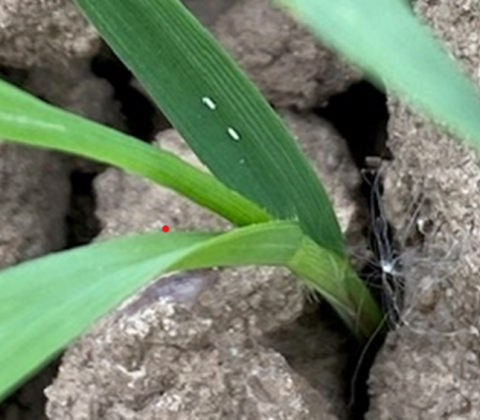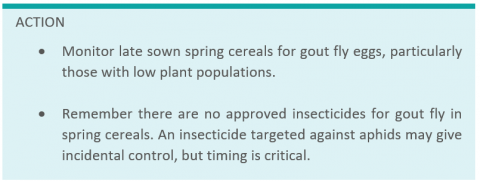Steve Ellis
This time last year we were starting to see gout fly eggs on spring cereals (Figure 1). Adult gout flies usually emerge in May/June and lay their eggs on leaves close to the central shoots. Late-sown winter and spring crops are at greatest risk from the spring generation and there are likely to be a lot of these this year. Crops at or beyond GS37 by mid-May in southern England or late May in the Midlands usually suffer only minor damage. Although the north of England is not mentioned in the literature one assumes this threshold date is even later than for the Midlands. Oats and maize are not affected.
Usually in spring sown cereals, if the attack is before stem elongation, the tiller will be stunted, swollen and gouty and never produce an ear. If the plant is more advanced there will be less severe damage. A poorly developed ear emerges with grains soiled on one side. There is no current threshold for gout fly in spring cereals.
There are no approved insecticides for gout fly in spring cereals although a pyrethroid applied against cereal aphids might give some incidental control. Timing is critical as once gout fly larvae are within the plants they are protected.

Figure 1. Gout fly eggs on spring wheat
The picture (Figure 1) shows very early infestation of spring wheat with gout fly eggs so any damage could occur during tillering. Losing the main shoot during tillering would be expected to result in the loss of later tillers that emerge from this shoot, so, the impact on final shoot number could be greater from early gout fly infestations compared with later infestations after the end of tillering. At present we do not have a good model for spring shoot production so our prediction of potential yield loss from gout fly is based on winter crops. If the main shoot is lost to gout fly in a crop with a low plant population (150 plants/m2), and 50% of plants are infested (the threshold for winter crops), the chances of reaching the target minimum of 500 shoots/m2 is reduced and it is likely that yield will suffer. However, crops with higher plant populations can probably afford to lose more main shoots to gout fly before there is an impact on yield.
A model for spring wheat shoot production could produce different results with lesser or grater impacts on yield. We would therefore be interested to hear of any reports of gout fly in spring cereals, and the levels of damage experienced, so we can improve the advice on managing this pest.

